University Business Law MCR009 Trimester 1 Final Exam Solution
VerifiedAdded on 2022/07/27
|9
|2686
|189
Homework Assignment
AI Summary
This document presents a comprehensive solution to a Business Law final examination (MCR009) from Trimester 1, 2020. The exam covers key areas of business law including contract law, tort law, and consumer law, with a focus on the Australian legal context. The solution addresses six compulsory questions, each with detailed answers and case analysis. Question 1 examines negligence in a food courier scenario, exploring duty of care, breach of duty, vicarious liability, and potential defenses. Question 2 analyzes a breach of contract case involving an online magazine, considering contract terms, termination rights, and remedies. Question 3 focuses on consumer guarantees under the ACL, concerning product quality and remedies for defective products. Question 4 tackles misleading advertising and deceptive conduct under the ACL. The answers provide legal principles, case law, and relevant provisions to support the arguments. The solution is an open-book exam, providing detailed answers to demonstrate an understanding of the course material.
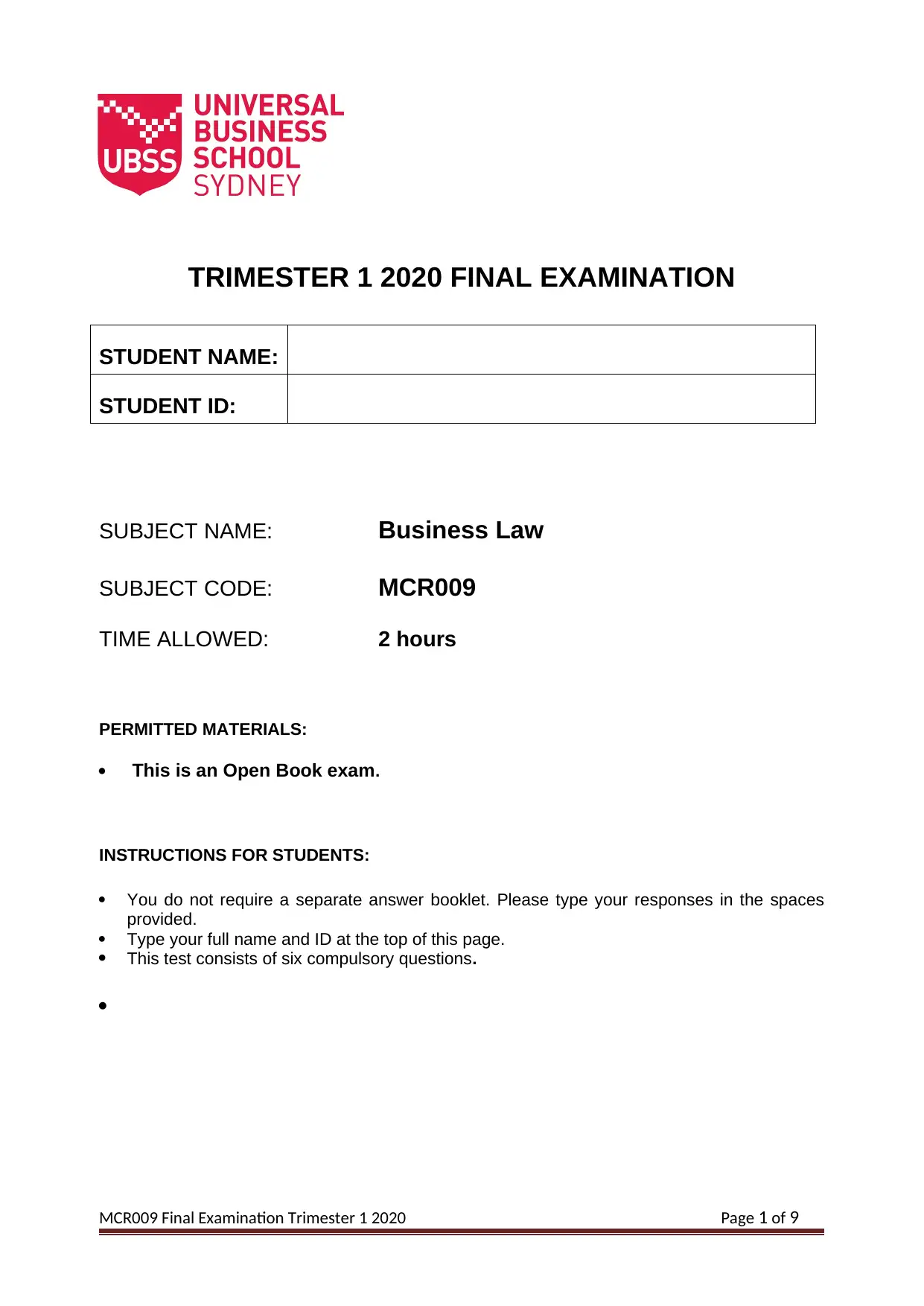
TRIMESTER 1 2020 FINAL EXAMINATION
STUDENT NAME:
STUDENT ID:
SUBJECT NAME: Business Law
SUBJECT CODE: MCR009
TIME ALLOWED: 2 hours
PERMITTED MATERIALS:
This is an Open Book exam.
INSTRUCTIONS FOR STUDENTS:
You do not require a separate answer booklet. Please type your responses in the spaces
provided.
Type your full name and ID at the top of this page.
This test consists of six compulsory questions.
MCR009 Final Examination Trimester 1 2020 Page 1 of 9
STUDENT NAME:
STUDENT ID:
SUBJECT NAME: Business Law
SUBJECT CODE: MCR009
TIME ALLOWED: 2 hours
PERMITTED MATERIALS:
This is an Open Book exam.
INSTRUCTIONS FOR STUDENTS:
You do not require a separate answer booklet. Please type your responses in the spaces
provided.
Type your full name and ID at the top of this page.
This test consists of six compulsory questions.
MCR009 Final Examination Trimester 1 2020 Page 1 of 9
Paraphrase This Document
Need a fresh take? Get an instant paraphrase of this document with our AI Paraphraser
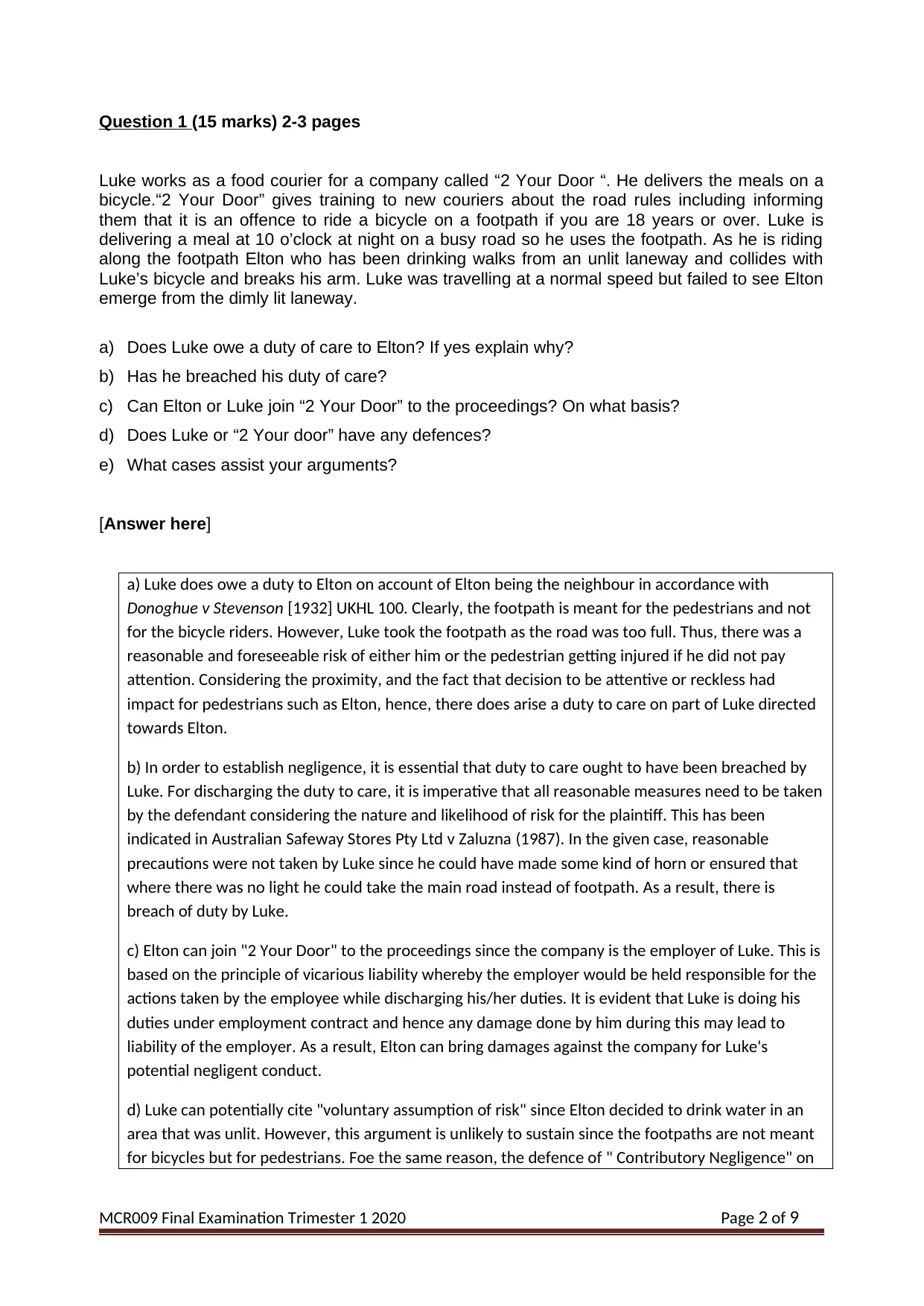
Question 1 (15 marks) 2-3 pages
Luke works as a food courier for a company called “2 Your Door “. He delivers the meals on a
bicycle.“2 Your Door” gives training to new couriers about the road rules including informing
them that it is an offence to ride a bicycle on a footpath if you are 18 years or over. Luke is
delivering a meal at 10 o’clock at night on a busy road so he uses the footpath. As he is riding
along the footpath Elton who has been drinking walks from an unlit laneway and collides with
Luke’s bicycle and breaks his arm. Luke was travelling at a normal speed but failed to see Elton
emerge from the dimly lit laneway.
a) Does Luke owe a duty of care to Elton? If yes explain why?
b) Has he breached his duty of care?
c) Can Elton or Luke join “2 Your Door” to the proceedings? On what basis?
d) Does Luke or “2 Your door” have any defences?
e) What cases assist your arguments?
[Answer here]
a) Luke does owe a duty to Elton on account of Elton being the neighbour in accordance with
Donoghue v Stevenson [1932] UKHL 100. Clearly, the footpath is meant for the pedestrians and not
for the bicycle riders. However, Luke took the footpath as the road was too full. Thus, there was a
reasonable and foreseeable risk of either him or the pedestrian getting injured if he did not pay
attention. Considering the proximity, and the fact that decision to be attentive or reckless had
impact for pedestrians such as Elton, hence, there does arise a duty to care on part of Luke directed
towards Elton.
b) In order to establish negligence, it is essential that duty to care ought to have been breached by
Luke. For discharging the duty to care, it is imperative that all reasonable measures need to be taken
by the defendant considering the nature and likelihood of risk for the plaintiff. This has been
indicated in Australian Safeway Stores Pty Ltd v Zaluzna (1987). In the given case, reasonable
precautions were not taken by Luke since he could have made some kind of horn or ensured that
where there was no light he could take the main road instead of footpath. As a result, there is
breach of duty by Luke.
c) Elton can join "2 Your Door" to the proceedings since the company is the employer of Luke. This is
based on the principle of vicarious liability whereby the employer would be held responsible for the
actions taken by the employee while discharging his/her duties. It is evident that Luke is doing his
duties under employment contract and hence any damage done by him during this may lead to
liability of the employer. As a result, Elton can bring damages against the company for Luke's
potential negligent conduct.
d) Luke can potentially cite "voluntary assumption of risk" since Elton decided to drink water in an
area that was unlit. However, this argument is unlikely to sustain since the footpaths are not meant
for bicycles but for pedestrians. Foe the same reason, the defence of " Contributory Negligence" on
MCR009 Final Examination Trimester 1 2020 Page 2 of 9
Luke works as a food courier for a company called “2 Your Door “. He delivers the meals on a
bicycle.“2 Your Door” gives training to new couriers about the road rules including informing
them that it is an offence to ride a bicycle on a footpath if you are 18 years or over. Luke is
delivering a meal at 10 o’clock at night on a busy road so he uses the footpath. As he is riding
along the footpath Elton who has been drinking walks from an unlit laneway and collides with
Luke’s bicycle and breaks his arm. Luke was travelling at a normal speed but failed to see Elton
emerge from the dimly lit laneway.
a) Does Luke owe a duty of care to Elton? If yes explain why?
b) Has he breached his duty of care?
c) Can Elton or Luke join “2 Your Door” to the proceedings? On what basis?
d) Does Luke or “2 Your door” have any defences?
e) What cases assist your arguments?
[Answer here]
a) Luke does owe a duty to Elton on account of Elton being the neighbour in accordance with
Donoghue v Stevenson [1932] UKHL 100. Clearly, the footpath is meant for the pedestrians and not
for the bicycle riders. However, Luke took the footpath as the road was too full. Thus, there was a
reasonable and foreseeable risk of either him or the pedestrian getting injured if he did not pay
attention. Considering the proximity, and the fact that decision to be attentive or reckless had
impact for pedestrians such as Elton, hence, there does arise a duty to care on part of Luke directed
towards Elton.
b) In order to establish negligence, it is essential that duty to care ought to have been breached by
Luke. For discharging the duty to care, it is imperative that all reasonable measures need to be taken
by the defendant considering the nature and likelihood of risk for the plaintiff. This has been
indicated in Australian Safeway Stores Pty Ltd v Zaluzna (1987). In the given case, reasonable
precautions were not taken by Luke since he could have made some kind of horn or ensured that
where there was no light he could take the main road instead of footpath. As a result, there is
breach of duty by Luke.
c) Elton can join "2 Your Door" to the proceedings since the company is the employer of Luke. This is
based on the principle of vicarious liability whereby the employer would be held responsible for the
actions taken by the employee while discharging his/her duties. It is evident that Luke is doing his
duties under employment contract and hence any damage done by him during this may lead to
liability of the employer. As a result, Elton can bring damages against the company for Luke's
potential negligent conduct.
d) Luke can potentially cite "voluntary assumption of risk" since Elton decided to drink water in an
area that was unlit. However, this argument is unlikely to sustain since the footpaths are not meant
for bicycles but for pedestrians. Foe the same reason, the defence of " Contributory Negligence" on
MCR009 Final Examination Trimester 1 2020 Page 2 of 9
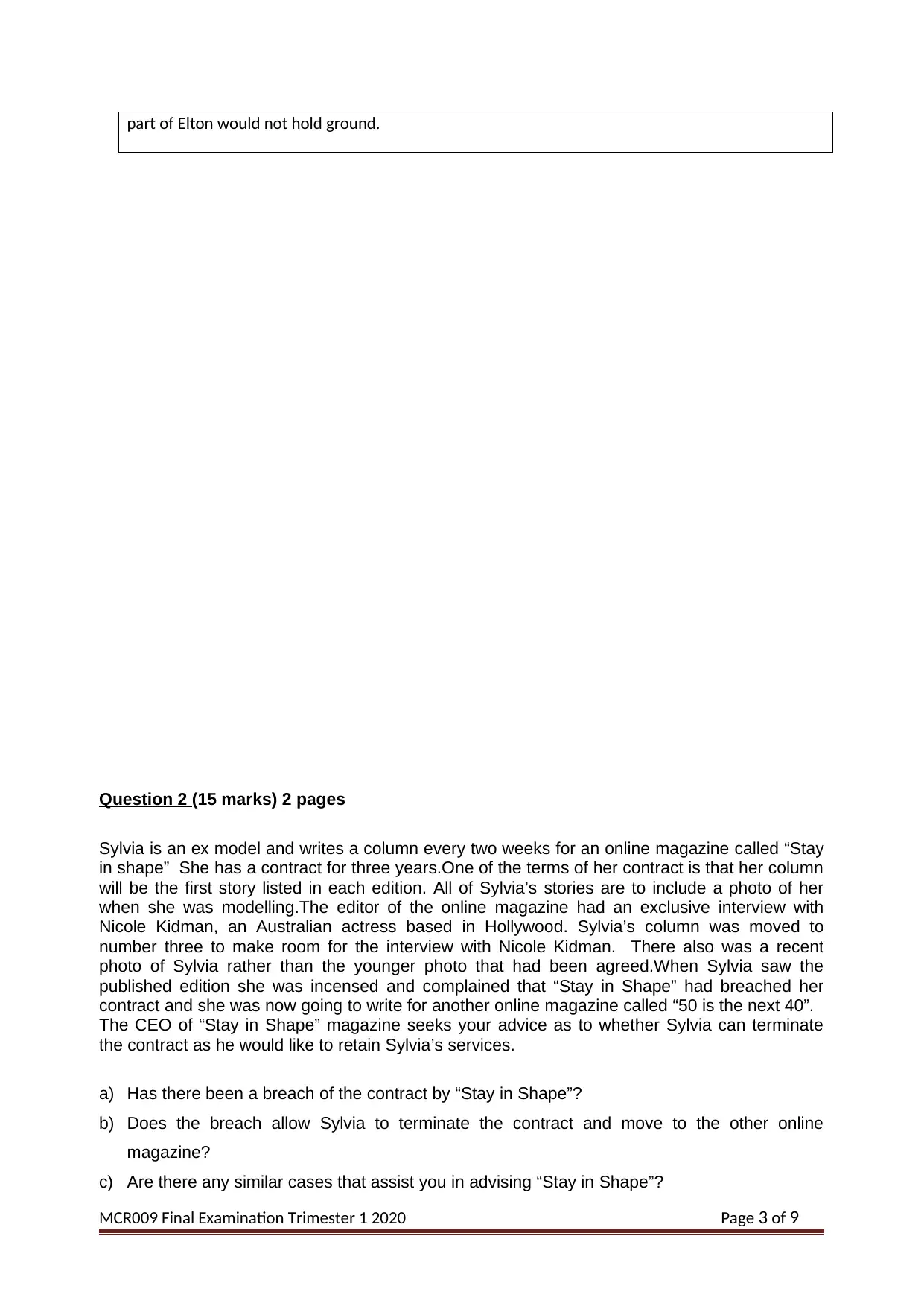
part of Elton would not hold ground.
Question 2 (15 marks) 2 pages
Sylvia is an ex model and writes a column every two weeks for an online magazine called “Stay
in shape” She has a contract for three years.One of the terms of her contract is that her column
will be the first story listed in each edition. All of Sylvia’s stories are to include a photo of her
when she was modelling.The editor of the online magazine had an exclusive interview with
Nicole Kidman, an Australian actress based in Hollywood. Sylvia’s column was moved to
number three to make room for the interview with Nicole Kidman. There also was a recent
photo of Sylvia rather than the younger photo that had been agreed.When Sylvia saw the
published edition she was incensed and complained that “Stay in Shape” had breached her
contract and she was now going to write for another online magazine called “50 is the next 40”.
The CEO of “Stay in Shape” magazine seeks your advice as to whether Sylvia can terminate
the contract as he would like to retain Sylvia’s services.
a) Has there been a breach of the contract by “Stay in Shape”?
b) Does the breach allow Sylvia to terminate the contract and move to the other online
magazine?
c) Are there any similar cases that assist you in advising “Stay in Shape”?
MCR009 Final Examination Trimester 1 2020 Page 3 of 9
Question 2 (15 marks) 2 pages
Sylvia is an ex model and writes a column every two weeks for an online magazine called “Stay
in shape” She has a contract for three years.One of the terms of her contract is that her column
will be the first story listed in each edition. All of Sylvia’s stories are to include a photo of her
when she was modelling.The editor of the online magazine had an exclusive interview with
Nicole Kidman, an Australian actress based in Hollywood. Sylvia’s column was moved to
number three to make room for the interview with Nicole Kidman. There also was a recent
photo of Sylvia rather than the younger photo that had been agreed.When Sylvia saw the
published edition she was incensed and complained that “Stay in Shape” had breached her
contract and she was now going to write for another online magazine called “50 is the next 40”.
The CEO of “Stay in Shape” magazine seeks your advice as to whether Sylvia can terminate
the contract as he would like to retain Sylvia’s services.
a) Has there been a breach of the contract by “Stay in Shape”?
b) Does the breach allow Sylvia to terminate the contract and move to the other online
magazine?
c) Are there any similar cases that assist you in advising “Stay in Shape”?
MCR009 Final Examination Trimester 1 2020 Page 3 of 9
⊘ This is a preview!⊘
Do you want full access?
Subscribe today to unlock all pages.

Trusted by 1+ million students worldwide
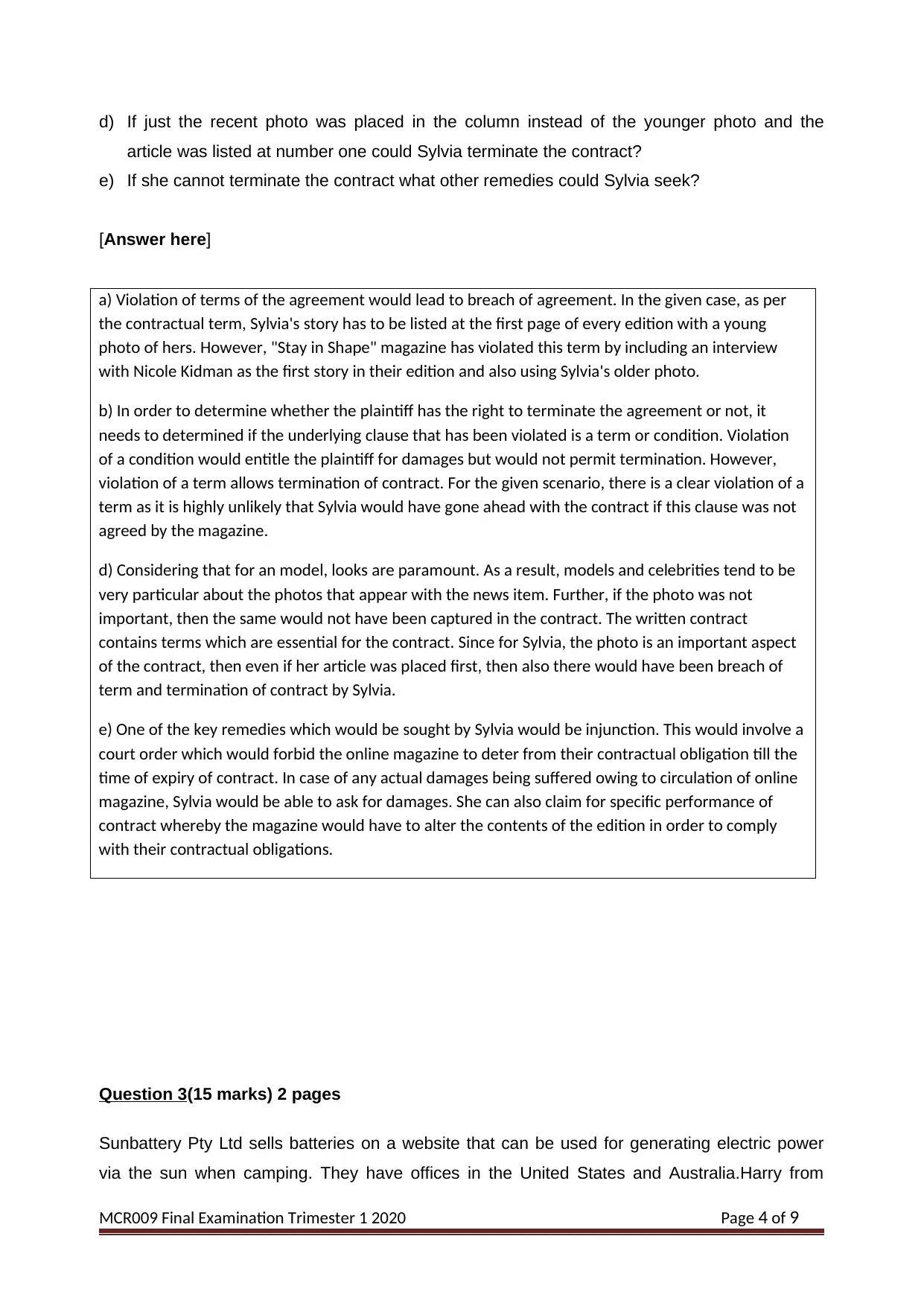
d) If just the recent photo was placed in the column instead of the younger photo and the
article was listed at number one could Sylvia terminate the contract?
e) If she cannot terminate the contract what other remedies could Sylvia seek?
[Answer here]
a) Violation of terms of the agreement would lead to breach of agreement. In the given case, as per
the contractual term, Sylvia's story has to be listed at the first page of every edition with a young
photo of hers. However, "Stay in Shape" magazine has violated this term by including an interview
with Nicole Kidman as the first story in their edition and also using Sylvia's older photo.
b) In order to determine whether the plaintiff has the right to terminate the agreement or not, it
needs to determined if the underlying clause that has been violated is a term or condition. Violation
of a condition would entitle the plaintiff for damages but would not permit termination. However,
violation of a term allows termination of contract. For the given scenario, there is a clear violation of a
term as it is highly unlikely that Sylvia would have gone ahead with the contract if this clause was not
agreed by the magazine.
d) Considering that for an model, looks are paramount. As a result, models and celebrities tend to be
very particular about the photos that appear with the news item. Further, if the photo was not
important, then the same would not have been captured in the contract. The written contract
contains terms which are essential for the contract. Since for Sylvia, the photo is an important aspect
of the contract, then even if her article was placed first, then also there would have been breach of
term and termination of contract by Sylvia.
e) One of the key remedies which would be sought by Sylvia would be injunction. This would involve a
court order which would forbid the online magazine to deter from their contractual obligation till the
time of expiry of contract. In case of any actual damages being suffered owing to circulation of online
magazine, Sylvia would be able to ask for damages. She can also claim for specific performance of
contract whereby the magazine would have to alter the contents of the edition in order to comply
with their contractual obligations.
Question 3(15 marks) 2 pages
Sunbattery Pty Ltd sells batteries on a website that can be used for generating electric power
via the sun when camping. They have offices in the United States and Australia.Harry from
MCR009 Final Examination Trimester 1 2020 Page 4 of 9
article was listed at number one could Sylvia terminate the contract?
e) If she cannot terminate the contract what other remedies could Sylvia seek?
[Answer here]
a) Violation of terms of the agreement would lead to breach of agreement. In the given case, as per
the contractual term, Sylvia's story has to be listed at the first page of every edition with a young
photo of hers. However, "Stay in Shape" magazine has violated this term by including an interview
with Nicole Kidman as the first story in their edition and also using Sylvia's older photo.
b) In order to determine whether the plaintiff has the right to terminate the agreement or not, it
needs to determined if the underlying clause that has been violated is a term or condition. Violation
of a condition would entitle the plaintiff for damages but would not permit termination. However,
violation of a term allows termination of contract. For the given scenario, there is a clear violation of a
term as it is highly unlikely that Sylvia would have gone ahead with the contract if this clause was not
agreed by the magazine.
d) Considering that for an model, looks are paramount. As a result, models and celebrities tend to be
very particular about the photos that appear with the news item. Further, if the photo was not
important, then the same would not have been captured in the contract. The written contract
contains terms which are essential for the contract. Since for Sylvia, the photo is an important aspect
of the contract, then even if her article was placed first, then also there would have been breach of
term and termination of contract by Sylvia.
e) One of the key remedies which would be sought by Sylvia would be injunction. This would involve a
court order which would forbid the online magazine to deter from their contractual obligation till the
time of expiry of contract. In case of any actual damages being suffered owing to circulation of online
magazine, Sylvia would be able to ask for damages. She can also claim for specific performance of
contract whereby the magazine would have to alter the contents of the edition in order to comply
with their contractual obligations.
Question 3(15 marks) 2 pages
Sunbattery Pty Ltd sells batteries on a website that can be used for generating electric power
via the sun when camping. They have offices in the United States and Australia.Harry from
MCR009 Final Examination Trimester 1 2020 Page 4 of 9
Paraphrase This Document
Need a fresh take? Get an instant paraphrase of this document with our AI Paraphraser
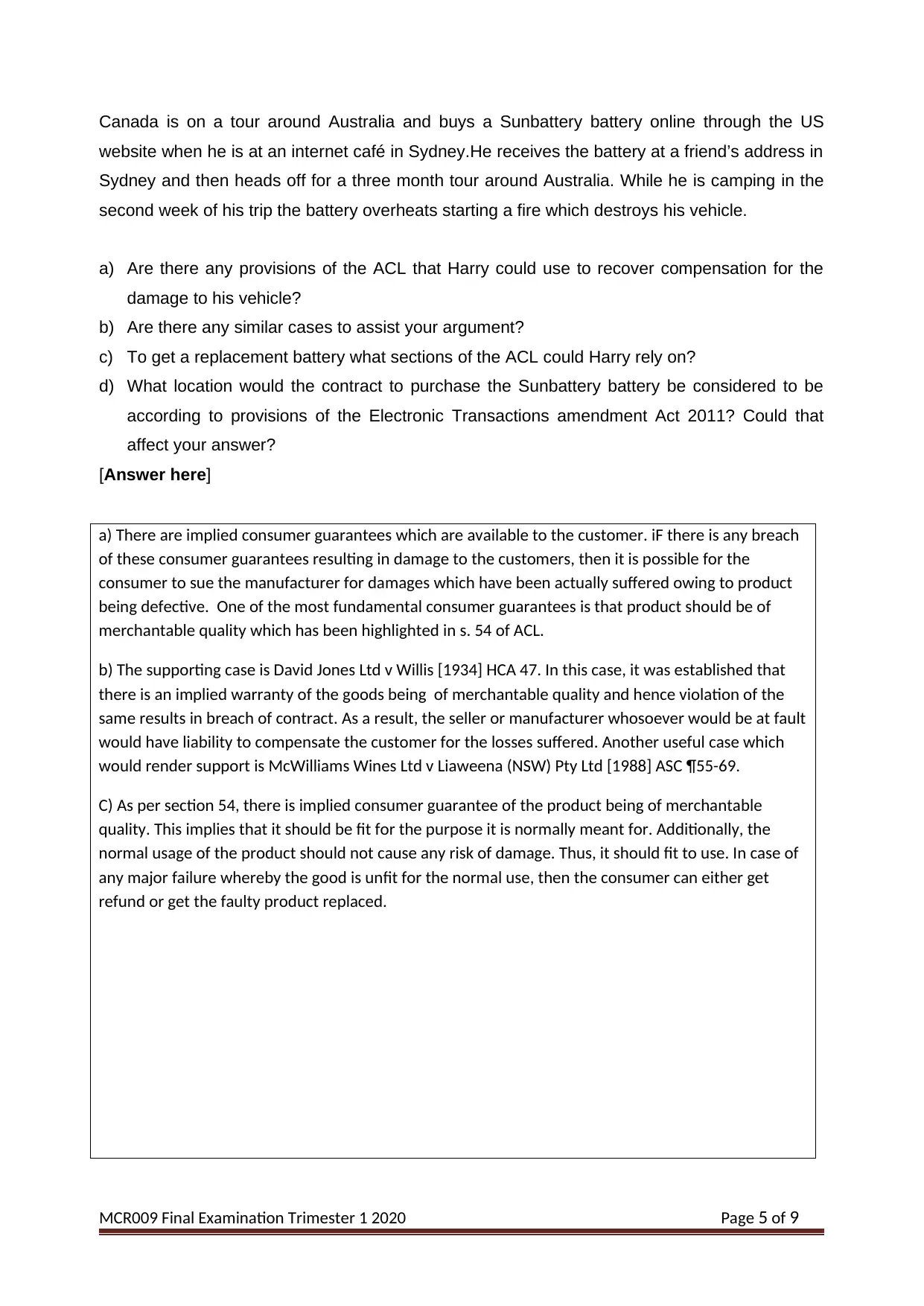
Canada is on a tour around Australia and buys a Sunbattery battery online through the US
website when he is at an internet café in Sydney.He receives the battery at a friend’s address in
Sydney and then heads off for a three month tour around Australia. While he is camping in the
second week of his trip the battery overheats starting a fire which destroys his vehicle.
a) Are there any provisions of the ACL that Harry could use to recover compensation for the
damage to his vehicle?
b) Are there any similar cases to assist your argument?
c) To get a replacement battery what sections of the ACL could Harry rely on?
d) What location would the contract to purchase the Sunbattery battery be considered to be
according to provisions of the Electronic Transactions amendment Act 2011? Could that
affect your answer?
[Answer here]
a) There are implied consumer guarantees which are available to the customer. iF there is any breach
of these consumer guarantees resulting in damage to the customers, then it is possible for the
consumer to sue the manufacturer for damages which have been actually suffered owing to product
being defective. One of the most fundamental consumer guarantees is that product should be of
merchantable quality which has been highlighted in s. 54 of ACL.
b) The supporting case is David Jones Ltd v Willis [1934] HCA 47. In this case, it was established that
there is an implied warranty of the goods being of merchantable quality and hence violation of the
same results in breach of contract. As a result, the seller or manufacturer whosoever would be at fault
would have liability to compensate the customer for the losses suffered. Another useful case which
would render support is McWilliams Wines Ltd v Liaweena (NSW) Pty Ltd [1988] ASC ¶55-69.
C) As per section 54, there is implied consumer guarantee of the product being of merchantable
quality. This implies that it should be fit for the purpose it is normally meant for. Additionally, the
normal usage of the product should not cause any risk of damage. Thus, it should fit to use. In case of
any major failure whereby the good is unfit for the normal use, then the consumer can either get
refund or get the faulty product replaced.
MCR009 Final Examination Trimester 1 2020 Page 5 of 9
website when he is at an internet café in Sydney.He receives the battery at a friend’s address in
Sydney and then heads off for a three month tour around Australia. While he is camping in the
second week of his trip the battery overheats starting a fire which destroys his vehicle.
a) Are there any provisions of the ACL that Harry could use to recover compensation for the
damage to his vehicle?
b) Are there any similar cases to assist your argument?
c) To get a replacement battery what sections of the ACL could Harry rely on?
d) What location would the contract to purchase the Sunbattery battery be considered to be
according to provisions of the Electronic Transactions amendment Act 2011? Could that
affect your answer?
[Answer here]
a) There are implied consumer guarantees which are available to the customer. iF there is any breach
of these consumer guarantees resulting in damage to the customers, then it is possible for the
consumer to sue the manufacturer for damages which have been actually suffered owing to product
being defective. One of the most fundamental consumer guarantees is that product should be of
merchantable quality which has been highlighted in s. 54 of ACL.
b) The supporting case is David Jones Ltd v Willis [1934] HCA 47. In this case, it was established that
there is an implied warranty of the goods being of merchantable quality and hence violation of the
same results in breach of contract. As a result, the seller or manufacturer whosoever would be at fault
would have liability to compensate the customer for the losses suffered. Another useful case which
would render support is McWilliams Wines Ltd v Liaweena (NSW) Pty Ltd [1988] ASC ¶55-69.
C) As per section 54, there is implied consumer guarantee of the product being of merchantable
quality. This implies that it should be fit for the purpose it is normally meant for. Additionally, the
normal usage of the product should not cause any risk of damage. Thus, it should fit to use. In case of
any major failure whereby the good is unfit for the normal use, then the consumer can either get
refund or get the faulty product replaced.
MCR009 Final Examination Trimester 1 2020 Page 5 of 9
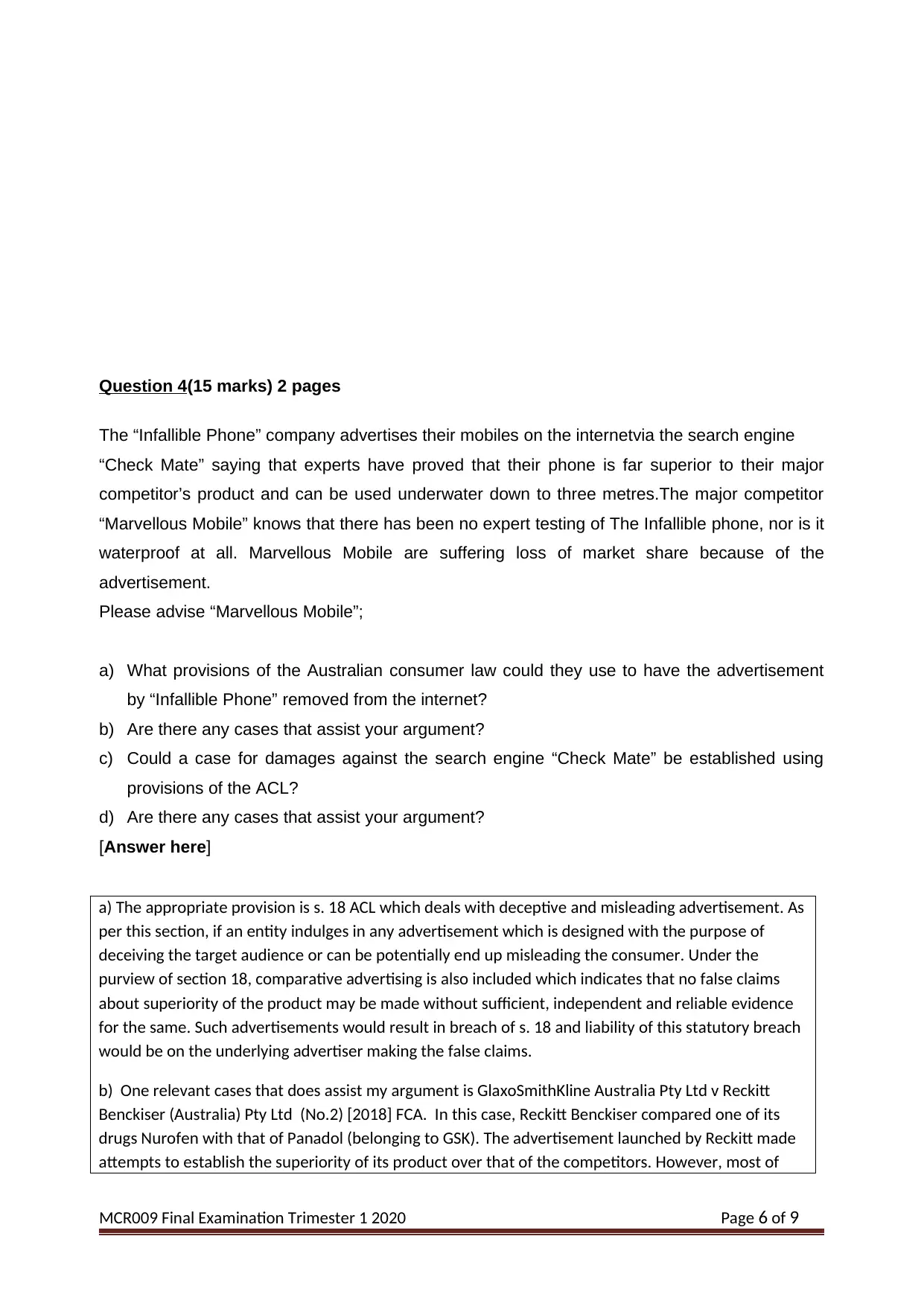
Question 4(15 marks) 2 pages
The “Infallible Phone” company advertises their mobiles on the internetvia the search engine
“Check Mate” saying that experts have proved that their phone is far superior to their major
competitor’s product and can be used underwater down to three metres.The major competitor
“Marvellous Mobile” knows that there has been no expert testing of The Infallible phone, nor is it
waterproof at all. Marvellous Mobile are suffering loss of market share because of the
advertisement.
Please advise “Marvellous Mobile”;
a) What provisions of the Australian consumer law could they use to have the advertisement
by “Infallible Phone” removed from the internet?
b) Are there any cases that assist your argument?
c) Could a case for damages against the search engine “Check Mate” be established using
provisions of the ACL?
d) Are there any cases that assist your argument?
[Answer here]
a) The appropriate provision is s. 18 ACL which deals with deceptive and misleading advertisement. As
per this section, if an entity indulges in any advertisement which is designed with the purpose of
deceiving the target audience or can be potentially end up misleading the consumer. Under the
purview of section 18, comparative advertising is also included which indicates that no false claims
about superiority of the product may be made without sufficient, independent and reliable evidence
for the same. Such advertisements would result in breach of s. 18 and liability of this statutory breach
would be on the underlying advertiser making the false claims.
b) One relevant cases that does assist my argument is GlaxoSmithKline Australia Pty Ltd v Reckitt
Benckiser (Australia) Pty Ltd (No.2) [2018] FCA. In this case, Reckitt Benckiser compared one of its
drugs Nurofen with that of Panadol (belonging to GSK). The advertisement launched by Reckitt made
attempts to establish the superiority of its product over that of the competitors. However, most of
MCR009 Final Examination Trimester 1 2020 Page 6 of 9
The “Infallible Phone” company advertises their mobiles on the internetvia the search engine
“Check Mate” saying that experts have proved that their phone is far superior to their major
competitor’s product and can be used underwater down to three metres.The major competitor
“Marvellous Mobile” knows that there has been no expert testing of The Infallible phone, nor is it
waterproof at all. Marvellous Mobile are suffering loss of market share because of the
advertisement.
Please advise “Marvellous Mobile”;
a) What provisions of the Australian consumer law could they use to have the advertisement
by “Infallible Phone” removed from the internet?
b) Are there any cases that assist your argument?
c) Could a case for damages against the search engine “Check Mate” be established using
provisions of the ACL?
d) Are there any cases that assist your argument?
[Answer here]
a) The appropriate provision is s. 18 ACL which deals with deceptive and misleading advertisement. As
per this section, if an entity indulges in any advertisement which is designed with the purpose of
deceiving the target audience or can be potentially end up misleading the consumer. Under the
purview of section 18, comparative advertising is also included which indicates that no false claims
about superiority of the product may be made without sufficient, independent and reliable evidence
for the same. Such advertisements would result in breach of s. 18 and liability of this statutory breach
would be on the underlying advertiser making the false claims.
b) One relevant cases that does assist my argument is GlaxoSmithKline Australia Pty Ltd v Reckitt
Benckiser (Australia) Pty Ltd (No.2) [2018] FCA. In this case, Reckitt Benckiser compared one of its
drugs Nurofen with that of Panadol (belonging to GSK). The advertisement launched by Reckitt made
attempts to establish the superiority of its product over that of the competitors. However, most of
MCR009 Final Examination Trimester 1 2020 Page 6 of 9
⊘ This is a preview!⊘
Do you want full access?
Subscribe today to unlock all pages.

Trusted by 1+ million students worldwide
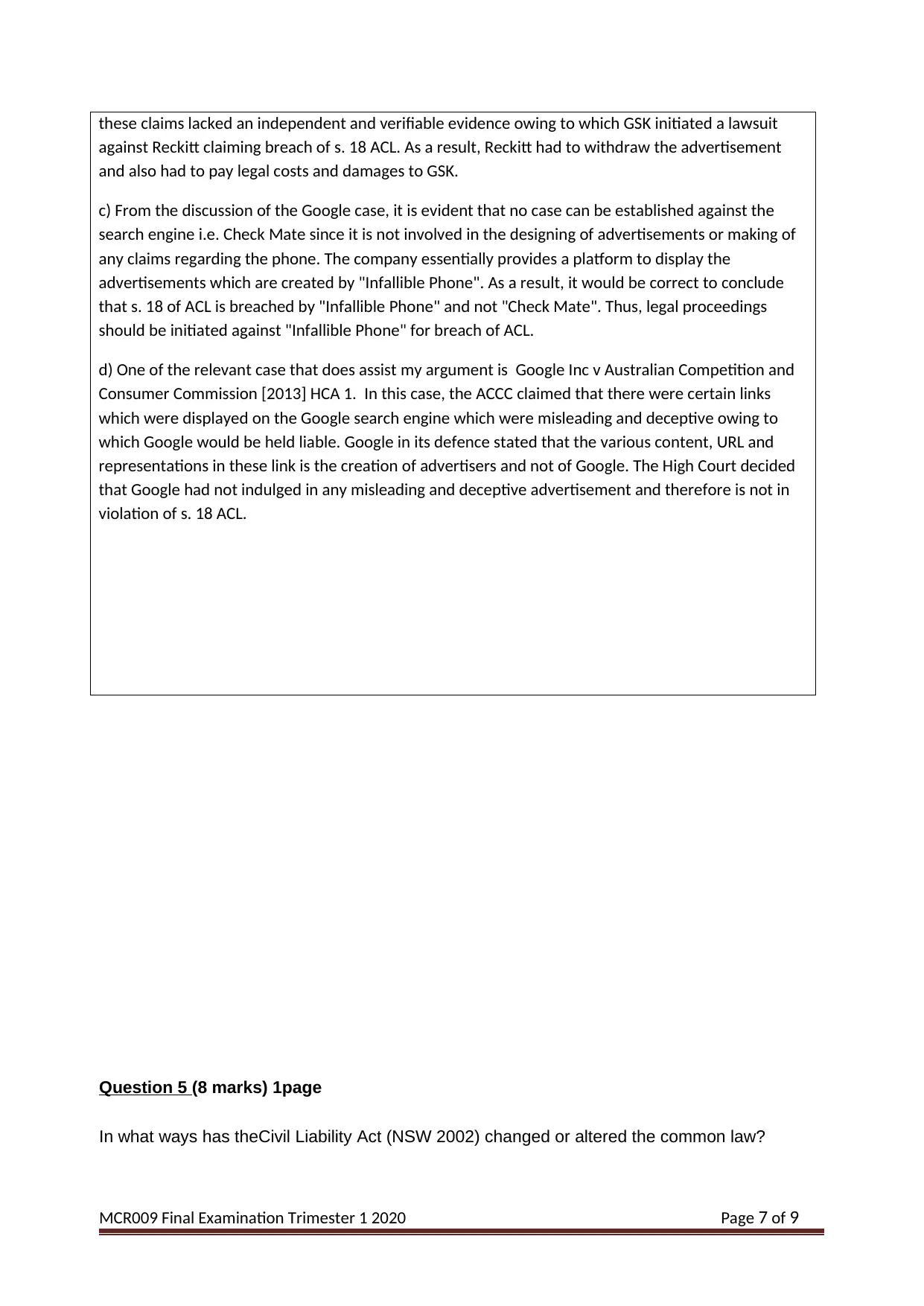
these claims lacked an independent and verifiable evidence owing to which GSK initiated a lawsuit
against Reckitt claiming breach of s. 18 ACL. As a result, Reckitt had to withdraw the advertisement
and also had to pay legal costs and damages to GSK.
c) From the discussion of the Google case, it is evident that no case can be established against the
search engine i.e. Check Mate since it is not involved in the designing of advertisements or making of
any claims regarding the phone. The company essentially provides a platform to display the
advertisements which are created by "Infallible Phone". As a result, it would be correct to conclude
that s. 18 of ACL is breached by "Infallible Phone" and not "Check Mate". Thus, legal proceedings
should be initiated against "Infallible Phone" for breach of ACL.
d) One of the relevant case that does assist my argument is Google Inc v Australian Competition and
Consumer Commission [2013] HCA 1. In this case, the ACCC claimed that there were certain links
which were displayed on the Google search engine which were misleading and deceptive owing to
which Google would be held liable. Google in its defence stated that the various content, URL and
representations in these link is the creation of advertisers and not of Google. The High Court decided
that Google had not indulged in any misleading and deceptive advertisement and therefore is not in
violation of s. 18 ACL.
Question 5 (8 marks) 1page
In what ways has theCivil Liability Act (NSW 2002) changed or altered the common law?
MCR009 Final Examination Trimester 1 2020 Page 7 of 9
against Reckitt claiming breach of s. 18 ACL. As a result, Reckitt had to withdraw the advertisement
and also had to pay legal costs and damages to GSK.
c) From the discussion of the Google case, it is evident that no case can be established against the
search engine i.e. Check Mate since it is not involved in the designing of advertisements or making of
any claims regarding the phone. The company essentially provides a platform to display the
advertisements which are created by "Infallible Phone". As a result, it would be correct to conclude
that s. 18 of ACL is breached by "Infallible Phone" and not "Check Mate". Thus, legal proceedings
should be initiated against "Infallible Phone" for breach of ACL.
d) One of the relevant case that does assist my argument is Google Inc v Australian Competition and
Consumer Commission [2013] HCA 1. In this case, the ACCC claimed that there were certain links
which were displayed on the Google search engine which were misleading and deceptive owing to
which Google would be held liable. Google in its defence stated that the various content, URL and
representations in these link is the creation of advertisers and not of Google. The High Court decided
that Google had not indulged in any misleading and deceptive advertisement and therefore is not in
violation of s. 18 ACL.
Question 5 (8 marks) 1page
In what ways has theCivil Liability Act (NSW 2002) changed or altered the common law?
MCR009 Final Examination Trimester 1 2020 Page 7 of 9
Paraphrase This Document
Need a fresh take? Get an instant paraphrase of this document with our AI Paraphraser
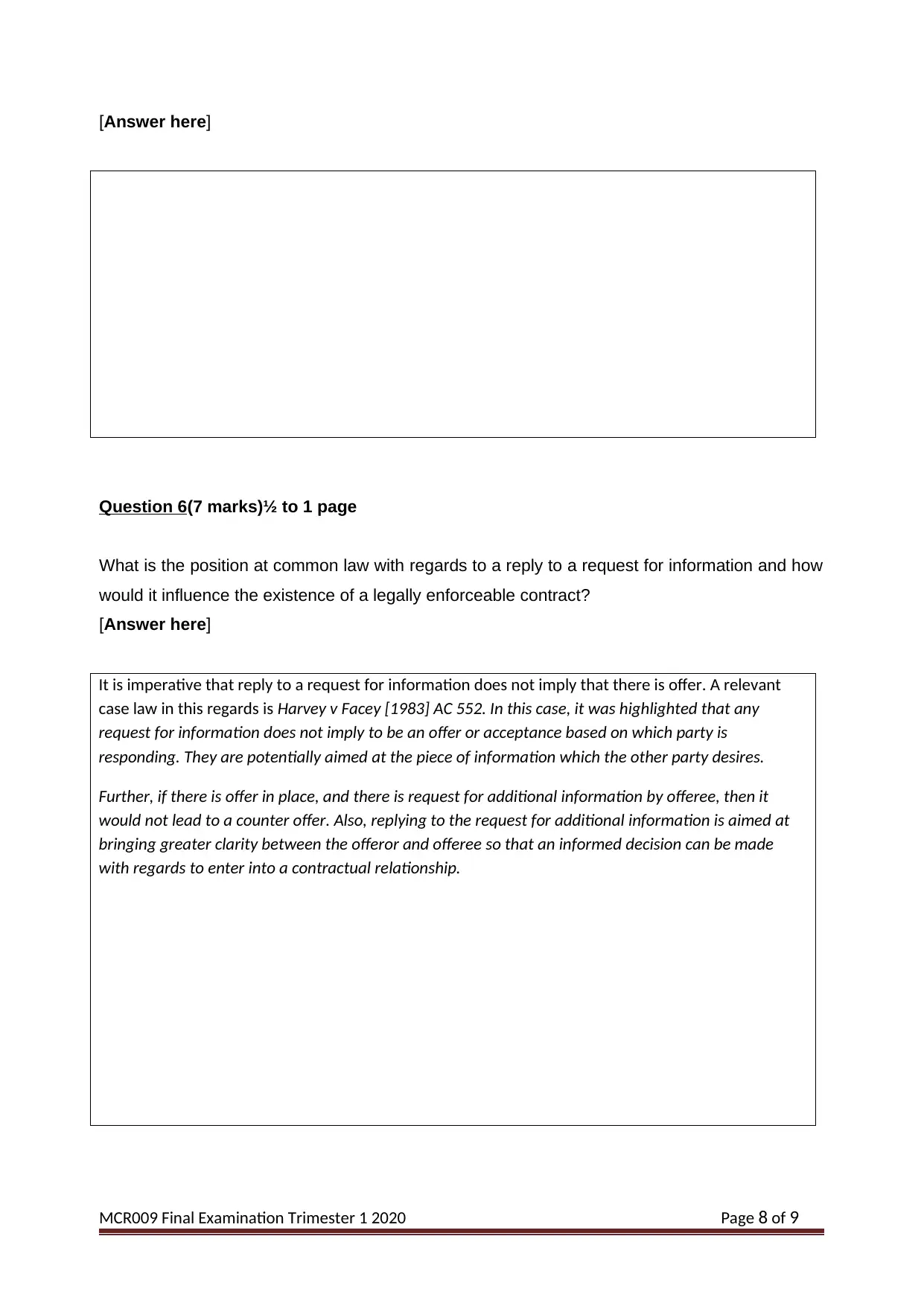
[Answer here]
Question 6(7 marks)½ to 1 page
What is the position at common law with regards to a reply to a request for information and how
would it influence the existence of a legally enforceable contract?
[Answer here]
It is imperative that reply to a request for information does not imply that there is offer. A relevant
case law in this regards is Harvey v Facey [1983] AC 552. In this case, it was highlighted that any
request for information does not imply to be an offer or acceptance based on which party is
responding. They are potentially aimed at the piece of information which the other party desires.
Further, if there is offer in place, and there is request for additional information by offeree, then it
would not lead to a counter offer. Also, replying to the request for additional information is aimed at
bringing greater clarity between the offeror and offeree so that an informed decision can be made
with regards to enter into a contractual relationship.
MCR009 Final Examination Trimester 1 2020 Page 8 of 9
Question 6(7 marks)½ to 1 page
What is the position at common law with regards to a reply to a request for information and how
would it influence the existence of a legally enforceable contract?
[Answer here]
It is imperative that reply to a request for information does not imply that there is offer. A relevant
case law in this regards is Harvey v Facey [1983] AC 552. In this case, it was highlighted that any
request for information does not imply to be an offer or acceptance based on which party is
responding. They are potentially aimed at the piece of information which the other party desires.
Further, if there is offer in place, and there is request for additional information by offeree, then it
would not lead to a counter offer. Also, replying to the request for additional information is aimed at
bringing greater clarity between the offeror and offeree so that an informed decision can be made
with regards to enter into a contractual relationship.
MCR009 Final Examination Trimester 1 2020 Page 8 of 9
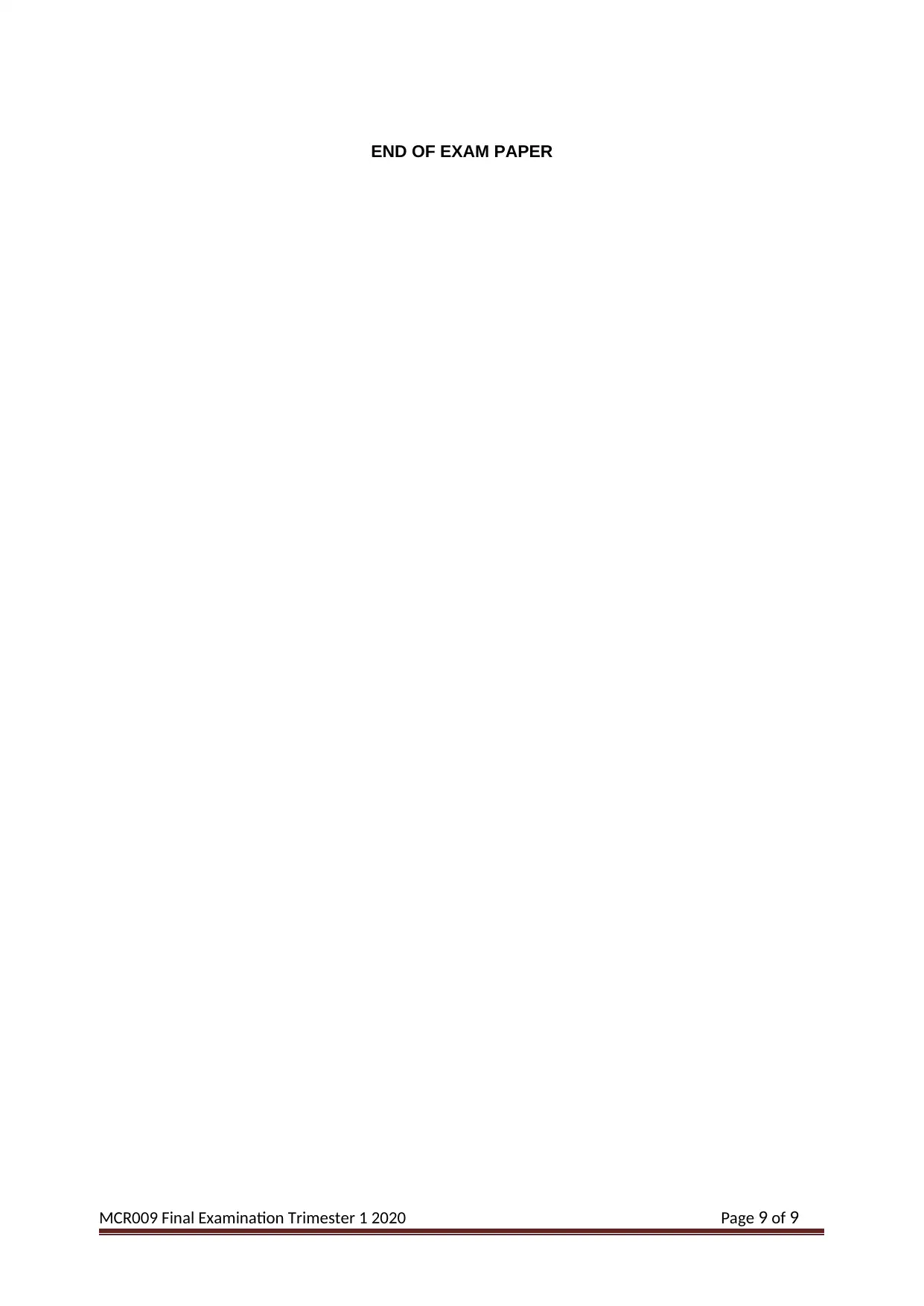
END OF EXAM PAPER
MCR009 Final Examination Trimester 1 2020 Page 9 of 9
MCR009 Final Examination Trimester 1 2020 Page 9 of 9
⊘ This is a preview!⊘
Do you want full access?
Subscribe today to unlock all pages.

Trusted by 1+ million students worldwide
1 out of 9
Your All-in-One AI-Powered Toolkit for Academic Success.
+13062052269
info@desklib.com
Available 24*7 on WhatsApp / Email
![[object Object]](/_next/static/media/star-bottom.7253800d.svg)
Unlock your academic potential
Copyright © 2020–2025 A2Z Services. All Rights Reserved. Developed and managed by ZUCOL.


